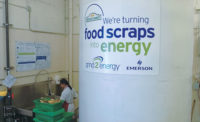Below the normal stacks in BYU’s Herald B. Lee Library sit the Special Collections vaults, containing the university’s most valued and cherished historic texts, artifacts and film.
The vaults are home to irreplaceable items, such as a piece of papyrus with scholarly notes from early Christianity, to more modern treasures such as the original manuscript of “Gone with the Wind.”
Such a collection provides an obvious challenge for many traditional fire protection systems — how do you stop a fire without dousing fragile books with water, or coating the objects with damaging chemicals?
BYU decided it needed to update the system in the vaults after a false discharge in another building caused damage. It hired AAA Fire Safety & Alarm of Layton, Utah as the contractor for the project, and the firm recommended the Victaulic Vortex hybrid fire-extinguishing system. AAA Vice President of Sales Matt Lauritzen notes the firm encouraged BYU to use the Vortex system because of its ability to stop fires without using large amounts of water or chemicals, and the room integrity requirements are not as strict, he says.
“It’s not a high-pressure system, so it wasn’t going to ruin anything if it did have a discharge,” he says. “It wasn’t going to spray chemicals all over the room. It wasn’t going to have a high-pressure release that was going to cause damage to articles in the room.”
Fire requires fuel, oxygen and heat. The Vortex system mixes nitrogen with atomized water particles, attacking the oxygen and heat legs of the basic fire triangle. In the event of a fire, the third leg, fuel, would include the collection’s books and highly flammable nitrate film if there was no fire protection system.
Using just inert gasses like nitrogen to fight a fire often requires reducing oxygen levels below safety for human occupancy, and it requires sealing the room. But by adding water, the system attacks the heat, in addition to the oxygen, meaning less nitrogen is needed to extinguish the fire. The Vortex system avoids water damage to the building or its contents by atomizing the water into tiny, sub-10-micron droplets, Victaulic applications engineer Steve Owens points out. Ten microns is about the diameter of a spider’s web. The water droplets remain suspended in the air after discharge, similar to a cloud.
“When you have that many water droplets, billions of water droplets, you have a lot more surface area than a regular water droplet from a sprinkler,” Owens says. “So the amount of water we put in there is minimal, but it has a very maximal affect. By putting them together you’re combining them into the fog. You use much less of either of the contributing factors.”
For BYU, this means no chemical- or water-damage concerns for the building’s objects, and oxygen levels are not being lowered to a point where there is immediate danger to life.
Using nitrogen, specifically, allows the system to work without ensuring room integrity.
“Oftentimes in a retrofit application, where they’re maybe converting a space, it can often be costly and challenging to get the tight room integrity to be able to pass the fan test,” says Daniel Edinger, Victaulic fire protection specialist. “Plus, there’s an expensive cost every time you have to do a fan test if you fail the first couple times.
“So the nice thing about nitrogen is, because our natural atmosphere has nitrogen in it, it becomes very buoyant. It doesn’t dissipate as quickly as most other gases would, like CO2 or others. So we have multiple demonstrations where you’ll have the door wide open, and we’ll discharge the nitrogen and water, and it’ll reduce the oxygen level for a pretty significant amount of time.”
Design
The system provides fire protection to four rooms: three “vaults,” and the fourth room with the photo and film archive. The photo room also contains a transitionary room where film is brought to room temperature before exiting.
The three vaults are each 34-feet long, 30-feet wide and 13-feet tall, and each is equipped with four emitters. The photo room has four emitters covering its 45-foot length, 30-foot width and 9-foot height. Another dedicated emitter covers its transitionary room, which is 8 feet by 9 feet with a 9-foot ceiling.
Each of the four rooms is designed as independent, separate systems, with separate control panels. AAA was able to use the existing detection system made by Ansul. Each of the three vaults has its own set of eight dedicated nitrogen cylinders. The photo room and its transition room have nine nitrogen cylinders altogether. Each room also has its own small water tank. Though if the system is triggered, the event would use less than a gallon of its contents per minute, as compared to sprinkler flows of about 30 gallons per minute, or a regular water mist nozzle at 4-5 gallons per minute. All of the tanks and controls are located below the rooms in a tunnel system that runs under all campus buildings.
“That’s kind of another nice thing about it, we didn’t have to put the nitrogen and the water in the hazard itself,” Lauritzen says “We can put it in a different location and pipe to it. If they have an accidental discharge, or a discharge, recharge costs are low, and we can have them back up and running in 24 hours. Whereas if it’s a chemical system, you’re down for weeks.”
From there, galvanized, 1/2-inch steel piping carries nitrogen, and 3/4-inch schedule 40 steel piping carries the water to the emitters where they converge into a single copper tube. The entire system runs without pumps – pressure from the nitrogen tanks moves the water through the pipes.
“Your nitrogen cylinders are obviously high pressure, but the second it leaves the cylinders, everything is regulated down to a lower pressure, 25 psi nitrogen and about 50 psi water,” Edinger says. “So it’s a very low-pressure system, and your nitrogen is just going to go through standard black pipe to the emitters.”
Value sell
Although the initial cost is higher, the overall cost of ownership is similar to other systems. For sensitive or unique applications like the vaults, or art galleries and data centers, some customers deem the initial higher price tag worth it, Lauritzen points out.
“This isn’t something where you’re going to competitively win (on price),” Lauritzen says. “This is a value-based sell. You’re bringing value to your customer and this is when you’re protecting real property and protecting things that are priceless that can’t be replaced. That’s when you want to start dealing with systems like this.”
Two demos, especially, won over the BYU administrators. In one demo, BYU opened some regular notebooks under the system and let it discharge. They were satisfied with the lack of water damage to the paper.
The other demo addressed a particular concern regarding the highly flammable film stored in one of the four rooms. Filmgoers who saw Quentin Tarantino’s “Inglorious Basterds” might recall one character torching a giant pile of such nitrate film, which quickly engulfs a building in flames.
“BYU’s big concern was when you burn this film it produces oxygen,” Edinger says. “So the whole goal is to displace oxygen, and if this is going to produce oxygen as it burns, will the system still effectively put it out? So they just brought a little piece of film, they lit it on fire and then they opened the door after they discharged in that room. We weren’t three steps in the room and it was out. So they were very satisfied.”
Following the library project, BYU has now used the Vortex for its other sensitive fire protection areas such as server rooms and chemical storage areas. It has stuck with less-expensive traditional systems for other areas.
For BYU, the benefits of having a system that is safer for occupants if the system discharged, and better protection from removing heat and oxygen from the fire, provided a much needed update to the storage vaults.






